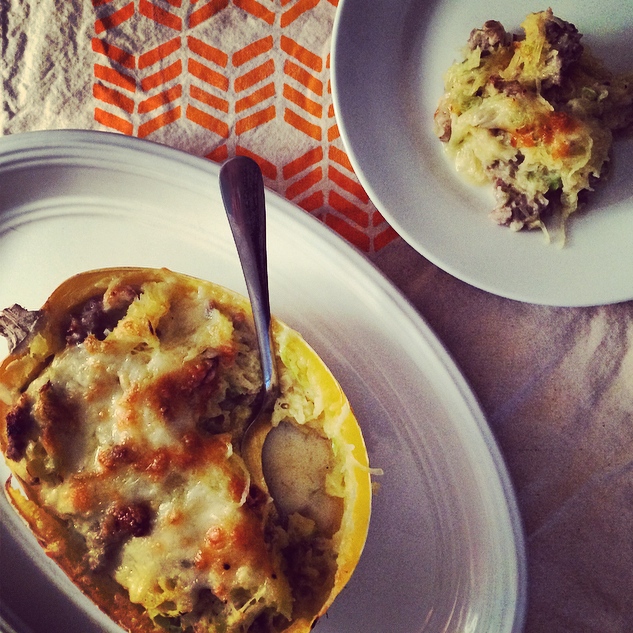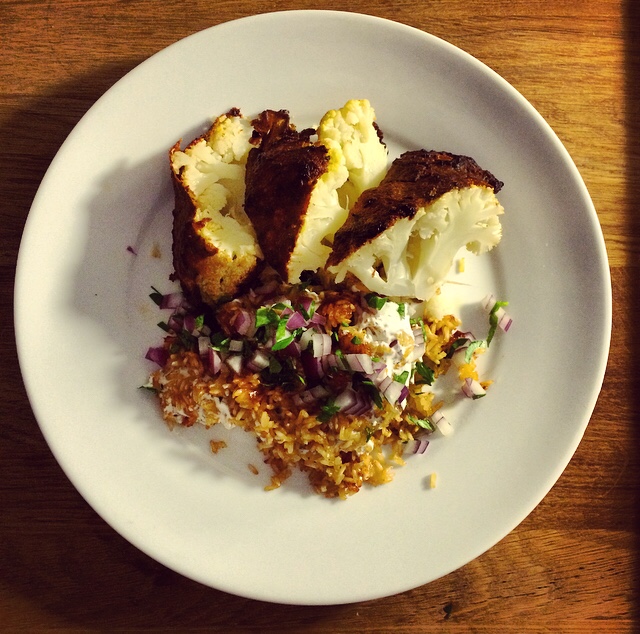With the nights drawing in and the first snow having fallen (albeit a very light dusting!) Winter is well and truly on its way.
That doesn’t mean that seasonal treats are lacking, though; now is the time for hearty winter squashes, robust leafed greens, warm spices and sweet roasted nuts and dried berries.
Roasting is your friend when the days get colder; it brings out the rich flavors of vegetables, intensifies sweetness and creates delicious texture.
 Loaded Spaghetti Squash- Serves 4
Loaded Spaghetti Squash- Serves 4
Spaghetti squash is an incredible vehicle for all kinds of saucy goodness. Unlike the mashed potato texture of many other cooked squashes, the flesh of the appropriately named spaghetti variety dissolves into delicate strands when steamed to tenderness.
3lb Spaghetti Squash
1lb Sweet Italian Sausage
6oz Leeks (with the very tough dark green tops removed)
1/4 pint Heavy Cream
4oz Cheddar Cheese
1 tablespoon Butter
Salt and Pepper
Cut the squash in half lengthways and scoop out the seeds and straggly innards and discard. Lay the squash cut side down on a baking dish, splash over a little water (a couple of tablespoons), and cover with foil.
Bake at 400F for half an hour. Check that the squash is cooked by giving it a jab with a fork. The tines should slide through the flesh easily. Turn the squash halves over and allow to steam, uncovered, while you prepare the rest of the filling. This will allow a lot of the excess water to evaporate from the squash and result in a lovely rich, baked finished dish.
Slice the sausages lengthways, peel away the casings and discard. Slice the leeks finely and fry in the butter. When the leeks have softened a little add in the sausage meat. Mash the sausage with a spatial or wooden spoon to break it into bite-sized pieces, fry until the meat is cooked through and starting to crisp and brown in places.
Use a fork to scrape the flesh of the squash into a large bowl; don’t break or tear the squash skins as you will be stuffing them to be baked again.
The fork will separate the strands. Give the squash a bit of a mix to completely loosen up the spaghetti-ness, but don’t mash it. The strands are delicate but will retain their shape when mixed gently.
Add the leeks and sausage to the bowl along with the cream and combine. Season to taste, then divide into the squash shells equally and top generously with grated cheese.
Return to the oven and bake for a further 20 minutes until the cheese is golden and bubbling.
Each squash side should satisfy two people; serve with some sautéed kale or chard for a hearty winter supper.
 Spiced Whole Cauliflower Roast– Serves 4 with sides
Spiced Whole Cauliflower Roast– Serves 4 with sides
Cauliflower is such a versatile vegetable; it can be mashed and enriched with cream and butter for a comfort food feat, finely diced and steamed as a skinny rice substitute or, like this recipe, roasted whole for a show-stopping center piece to a vegetarian dinner.
1 whole head of cauliflower
2 tablespoons greek yogurt
1 teaspoon paprika
1 teaspoon curry powder
1 teaspoon ground cumin
1 teaspoon ground coriander
1 teaspoon dried chili flakes
1 teaspoon turmeric
1 teaspoon dried mint
1 teaspoon dried parsley
3 or 4 cardamom pods – split with the seeds removed
salt and pepper
olive oil for roasting
Mix the yogurt with the spices, salt and pepper until they make a thick burnt umber paste.
Peel back the green leaves of the cauliflower and cut away the stalk that protrudes from the bottom of the cauliflower head. You want it to remain as one whole piece, but with as much stalk removed as you can without it breaking into hemispheres.
Place the cauliflower, stalk side down, in a baking tray and slather it with the paste. Use the back of a spoon to coat every part of the milky white surface.
Pop the cauliflower in the fridge to marinate for at least an hour; if you can leave it overnight, all the better.
When you are ready to cook, preheat the oven to 400F. Drizzle a little olive oil over the cauliflower, this will help the surface crisp, then roast for about 35-40 minutes until the yogurt crust is golden brown.
Serve in great wedges with rice, minted yogurt dressing and a fresh simple salad of red onion and fragrant flat leaf parsley.
Bacon and Chestnut Sprouts– serves 4 as a side dish
Brussels sprouts are a subject of much division, especially back home in England where the tendency is to over cook them and leave them bitter and mushy.
Sprouts can be successfully boiled or steamed until just tender, tossed in herbed butter and be delicious, but they are particularly good when shredded, sautéed and mixed with bacon!
12oz Fresh Brussels Sprouts
6 oz Bacon
1 lb Whole Chestnuts (if you can get then pre-peeled then only 6oz)
If, like me, you are unable to find prepared chestnuts, it’s best to get these sorted before you start on anything else.
Cut a small nick into each of the chestnut shells and tumble into a pan of boiling water. Simmer on a high heat for 15 minutes before draining and leaving to cool. Once cooled, you will need to peel back the tough outer layer and as much of the softer, thinner layer inside as you can. The softer inner layer is a bit like the skin of a peanut. Ideally you don’t want to eat it, but a little bit isn’t going to be a terrible disaster.
While the chestnuts are cooking, you can slice up the sprouts, if you want to have a very fine texture you can use a mandolin to shave them into thin ribbons, but I like a bit of bite so I aim to cut each sprout into about four slices.
Slice the bacon into small pieces and fry in a large sauté pan with a little touch of oil to get the bacon crisping. When the bacon is browned and crispy, tumble in the sprouts to sauté in the bacon fat. The sprouts will take about 10 minus on a medium high heat if you go for my chunkier style slicing; if you’ve gone super thin they’ll be done in about 5.
Keep moving the sprouts around the pan so that they cook evenly; some will catch a little more color than others because of the bacon fat, but this will add to the flavor.
When the sprout are cooked, tender and a little browned here and there, turn out the heat under the pan and crumble in the chestnuts. The chestnuts will add sweetness and further texture, keep some in larger chunks (about a quarter of the whole nut) and some a lovely little crumbles that will coat the sprouts.
These are great served warm alongside a traditional Thanksgiving dinner or as a fine accompaniment to roasted chicken.
More Posts by The Author:
RI Food Trucks Are UnBOOlievable
Who Let the Dogs Out? Downcity Dog Days at Aurora
Food Trucks Are Rolling in the Summer Streets
Locale Profile: The Village
Locale Profile: The Salted Slate


